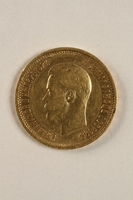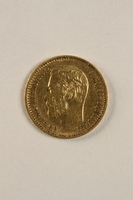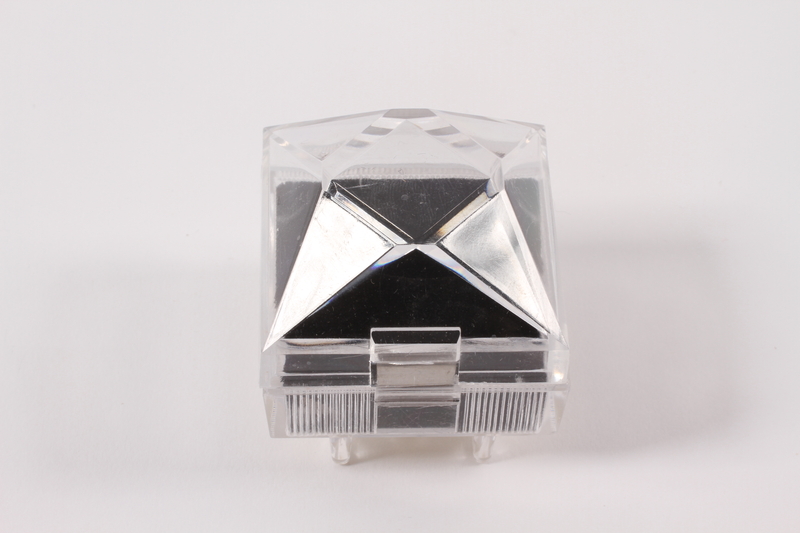Overview
- Brief Narrative
- Pin inscribed HIAS Bremen 1946 with a display case and a cardboard box given to 8 year old Henikel Minuskin in 1946 when he emigrated from Germany to the United States with his family on board the Marine Marlin. After his hometown, Zhetel, Poland, was occupied by Germany in June 1941, he and his family lived with partisans in the Lipichanski forest in Poland (Bialowieza Forest (Poland and Belarus) from 1942-1944. His father, Shlamke, was a member of the Lenin Partisan Brigade and Henikel, his mother, Shanke, and his baby brother, Kalmanke, lived with the group. The area was liberated by the Soviet Army in September 1944. When the war ended in May 1945, the family went to Zeilsheim displaced persons camp in Germany. With the assistance of the Hebrew Immigrant Aid Society (HIAS), the family emigrated to the United States, arriving in New York on September 6, 1946.
- Date
-
received:
1946
- Geography
-
received:
Marine Marlin (Ship);
Bremen (Germany)
- Credit Line
- United States Holocaust Memorial Museum Collection, Gift of Harold Minuskin
- Markings
- front, blue ink : HIAS / Bremen / 1946 / Hebrew characters [HIAS]
- Contributor
-
Subject:
Harold Minuskin
Distributor: Hebrew Immigrant Aid Society (HIAS)
- Biography
-
Henikel (Henach) Minuskin was born on July 22, 1938, to Shlamke, born on March 12, 1905, and Shanke Orlinsky Minuskin, born on September 17, 1914. He had one brother, Kalmanke, born on August 17, 1940. All of the family members were born in Zhetel, Poland (Dziatlava, Belarus). They lived in a home built by his father and his four brothers. Shlamke owned a bus transportation business. Shanke was trained as a hairdresser and manicurist. On September 17, 1939, the Soviets invaded and occupied eastern Poland, and Zhetel came under Soviet control. Shortly after the invasion, Shlamke prepared a secret hiding place under the outhouse in the backyard. On June 30, 1941, Germany invaded the Soviet Union and occupied Zhetel. The persecution of Jews became increasingly violent and on July 23, 1941, German mobile killing units murdered about 120 prominent members of the Jewish community, including Harold’s maternal uncle, Leib Orlinsky. On February 22, 1942, the Germans put up posters ordering all Jews to move into the ghetto which was established in the area where Harold’s family lived. They had to share their home with several others. On August 6, 1942, the Germans began the final liquidation of the ghetto. Shlamke was rounded up during the massacre and locked with hundreds of others in the synagogue. He was able to hide in the rafters in the midst of the confusion. After two days, he escaped into the Belorussian forest and joined the Jewish partisan resistance.
During this time, Henik, Kalmanke, Sonia, and eight others hid in the underground hiding place. After three days, Shanke decided to flee with her sons to the nearby forest. Harold’s grandmother, Rivka Orlinsky, suffered from poor eyesight, so an aunt remained behind with her. Both were captured by the Germans and shot and killed the following day. Shanke and the boys received shelter and food from some peasants and farmers that Shanke knew, but many were afraid of the Germans and would not help. They slept in ditches and fields some nights. Shlamke found them hiding in a root cellar and led them to the partisan unit’s base in the Lipiczanski (Lipichanski) forest. He was a private in the Lenin Partisan Brigade. The boys and their mother stayed in camouflaged underground dugouts [zemlyankas] when the unit went on missions to sabotage German troops or eliminate collaborators. The group had to keep moving to avoid capture by the Germans.
Living conditions were harsh; the family often had little food and many partisans perished from the cold and disease. The family subsisted on food acquired from local peasants or wild food from the forest. They had a supply of Russian Czarist era gold coins which they used to get supplies, but they often were not accepted and the partisans took things by force. Shanke would venture out at night to find milk or bread. She served as a seamstress for the partisans. She made the family clothing from silk parachutes left behind by Soviet officers and sewed coats for Harold and Carl from a German great coat. The boys had Russian aviator’s hats that were also scavenged n the woods. Harold’s father taught him to shoot a rifle and load machine gun magazines and he helped his mother saw logs to build shelters. The area was liberated on September 7, 1944, by the Soviet Army.
The family briefly returned to their home in Zhetel after the war ended in May 1945. They decided not to stay because of the still strong anti-Semitism. In November 1945, they arrived at Zeilsheim displaced persons camp near Frankfurt am Main, Germany. Their names were listed by the Red Cross as survivors of the war. Harold’s maternal aunt, Helen Orlinsky Gulfetta, who lived in New York, saw their names and sponsored their emigration to the United States. On September 16, 1946, the family emigrated to the US on the Marine Marlin. They Americanized their names to Harold, Carl, Sonia, and Sam. Harold received a masters in electrical engineering from the University of California, and was a senior design engineer at the Jet Propulsion Laboratory. He married Arlene and had two children. In 2009, he translated his mother’s memoir of their wartime experiences. Sam died on August 14, 1984, age 79. Sonia died on November 7, 2008, age 94.
HIAS, the Hebrew Immigrant Aid Society, was founded in the 1881 in the Lower East Side of New York City. Their original mission was to rescue Jews in Eastern Europe and Russia who were being persecuted and murdered in pogroms. They provided the recent refugees with meals and shelter, and helped them find jobs. In 1904, HIAS set up an office on Ellis Island and expanded their aid services to new arrivals, guiding them through the immigration process, preventing deportations, and searching for relatives. The organization expanded during the interwar years to ensure that Jewish refugees could find welcome and safety in their new countries. HIAS helped form HICEM, a joint bureau of three aid agencies established in Paris to centralize eastern European immigration. By the 1930s, the American Jewish Joint Distribution Committee (AJDC) provided most of the money and HIAS provided the majority of the staff members. After the occupation of France by Nazi Germany in June 1940, the office moved to Marseille and an office was opened in Lisbon, Portugal. HIAS continued to assist refugees in America during World War II (1939-1945), but the restrictive immigration policies of the US government severely limited new arrivals. After the war ended in May 1945, HIAS was instrumental in the resettlement of hundreds of thousands of displaced persons to communities in the US and around the world. In this century, their mission was expanded to aid non-Jewish persons. HIAS continues to work on the front lines, assisting refugees no matter where they are.
Physical Details
- Classification
-
Identifying Artifacts
- Category
-
Badges
- Object Type
-
Pin-back buttons (lcsh)
- Physical Description
- a. Circular, plastic coated cardboard pin with a metal straight pin closure on the back. The front is discolored white with English and Hebrew text in blue ink and 2 blue 8-sided stars printed on opposite sides of the border. There is a smaller, blue ink, circular outline in the center with English text and the date. The reverse is black.
b. Clear, diamond cut plastic square box with a metal hinged lid. There is a square shaped cardboard insert covered in black velvet with a slit cut in the top to insert the pin clasp (a). It is open on the bottom and a piece of foam is glued to the interior for support. There is a square shaped piece of cardboard with one silver side inserted in the base. On the base underside is a gold oval sticker with English text in black ink.
c. Square cube shaped black cardboard box with an oval cut out on the top. It is a fold together box with a fold down lid section. - Dimensions
- a: Depth: 0.250 inches (0.635 cm) | Diameter: 1.375 inches (3.493 cm)
b: Height: 2.000 inches (5.08 cm) | Width: 1.875 inches (4.763 cm) | Depth: 1.875 inches (4.763 cm)
c: Height: 2.000 inches (5.08 cm) | Width: 2.000 inches (5.08 cm) | Depth: 2.000 inches (5.08 cm) - Materials
- a : cardboard, metal, ink, plastic
b : plastic, cloth, metal, paper
c : ink
: cardboard - Inscription
- underside of base, on sticker in black ink : MADE IN / CHINA
Rights & Restrictions
- Conditions on Access
- No restrictions on access
- Conditions on Use
- No restrictions on use
Keywords & Subjects
- Topical Term
- Hidden children in the Holocaust--Belarus--Dziatlava. Holocaust, Jewish (1939-1945)--Belarus--Dziatlava. Jewish children in the Holocaust--Belarus--Dziatlava. Jewish refugees--Germany. World War, 1939-1945--Jewish resistance. Lenin Partisan Brigade (Belarus) World War, 1939-1945--Underground movements--Poland.
Administrative Notes
- Legal Status
- Permanent Collection
- Provenance
- The souvenir pin and boxes were donated to the United States Holocaust Memorial Museum in 2010 by Harold Minuskin, the son of Sonia Minuskin.
- Funding Note
- The cataloging of this artifact has been supported by a grant from the Conference on Jewish Material Claims Against Germany.
- Record last modified:
- 2022-07-28 21:51:09
- This page:
- https://collections.ushmm.org/search/catalog/irn42512
Also in Harold Minuskin family collection
The collection consists of two Russian ruble coins and a HIAS pin relating to the experiences of Shanke (Sonia) Minuskin, her husband Shlamke, and their two children, Henikel and Kalmanke, while living in hiding in Bialowieza Forest in Poland and Belarus during the Holocaust and in Zeilsheim displaced persons camp in Germany after World War II.
Date: 1942-1946

Imperial Russia, gold 10 ruble coin saved by a Jewish Polish family living in hiding with partisans
Object
10 ruble gold coin hidden by Shanke Minuskin when she and her family lived with partisans in the Lipichanski forest in Poland (Bialowieza Forest (Poland and Belarus) from 1942-1944. The coins were used to bargain for food, clothing, and weapons from the local peasants; if the currency was not accepted, force often was used instead. Shanke, her husband, Shlamke, her sons, 3 year old Henikel and 1 year old Kalmanke, fled Zhetel, Poland, shortly after it was occupied by Germany in June 1941. Shlamke escaped to the Belorussian forest where he joined a group of partisan fighters. Shanke and the children fled a few days later. They were hiding in a root cellar near the forest when Shlamke found them. He participated in the guerrilla action against the Germans while Shanke repaired and sewed clothing. The area was liberated by the Soviet Army in September 1944. When the war ended in May 1945, the family went to the Zeilsheim displaced persons camp in Germany and then emigrated to the United States in September 1946.

Imperial Russia, gold 5 ruble coin saved by a Jewish Polish family living with partisans
Object
5 ruble gold coin hidden by Shanke Minuskin when she and her family lived with partisans in the Lipichanski forest in Poland (Bialowieza Forest (Poland and Belarus) from 1942-1944. The coins were used to bargain for food, clothing, and weapons from the local peasants; if the currency was not accepted, force often was used instead. Shanke, her husband, Shlamke, her sons, 3 year old Henikel and 1 year old Kalmanke, fled Zhetel, Poland, shortly after it was occupied by Germany in June 1941. Shlamke escaped to the Belorussian forest where he joined a group of partisan fighters. Shanke and the children fled a few days later. They were hiding in a root cellar near the forest when Shlamke found them. He participated in the guerrilla action against the Germans while Shanke repaired and sewed clothing. The area was liberated by the Soviet Army in September 1944. When the war ended in May 1945, the family went to the Zeilsheim displaced persons camp in Germany and then emigrated to the United States in September 1946.






